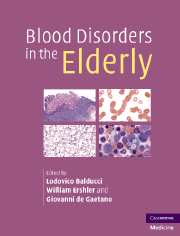Book contents
- Frontmatter
- Contents
- List of contributors
- Preface
- Part I Epidemiology
- Part II Hematopoiesis
- Part III Anemia of aging
- Part IV Hematologic malignancies and aging
- 18 Cancer chemotherapy in the older person
- 19 Acute myeloid leukemia in the elderly
- 20 Acute lymphoblastic leukemia in the elderly patient: diagnosis and therapy
- 21 Multiple myeloma
- 22 Non-Hodgkin lymphoma
- 23 Unusual lymphomas in the elderly
- 24 Chronic lymphocytic leukemia in the elderly
- 25 Polycythemia vera and idiopathic myelofibrosis in the elderly
- Part V Disorders of hemostasis in the elderly
- Index
20 - Acute lymphoblastic leukemia in the elderly patient: diagnosis and therapy
from Part IV - Hematologic malignancies and aging
Published online by Cambridge University Press: 21 October 2009
- Frontmatter
- Contents
- List of contributors
- Preface
- Part I Epidemiology
- Part II Hematopoiesis
- Part III Anemia of aging
- Part IV Hematologic malignancies and aging
- 18 Cancer chemotherapy in the older person
- 19 Acute myeloid leukemia in the elderly
- 20 Acute lymphoblastic leukemia in the elderly patient: diagnosis and therapy
- 21 Multiple myeloma
- 22 Non-Hodgkin lymphoma
- 23 Unusual lymphomas in the elderly
- 24 Chronic lymphocytic leukemia in the elderly
- 25 Polycythemia vera and idiopathic myelofibrosis in the elderly
- Part V Disorders of hemostasis in the elderly
- Index
Summary
Epidemiology
In adults, acute lymphoblastic leukemia (ALL) is a rare disease with a poor prognosis. An estimated 3970 new cases of ALL (all ages) were diagnosed in the USA during 2005. The incidence of the disease peaks in the age group 1 to 4 years, with 7.2 cases per 100 000. From ages 20 to 60 years the incidence decreases to less than 1 per 100 000. A secondary increase is noted after age 60, peaking at age 85+ with 1.6 cases expected per 100 000. Among adults, approximately 30% of ALL cases arise in patients aged 60 years or older.
Similar findings have been reported from other countries, such as the population-based study by Taylor and coworkers from the Northern Health Region of England (approximately 3 million people). Over the 8.5-year study period, 157 cases of ALL in adults (age >15) were identified. Of these cases, 31% were individuals aged over 60 (annual incidence 0.9 per 100 000). In the Western Swedish Health Care Region, the incidence of ALL was 0.72 per 100 000 in patients over the age of 65 (1982–96). In this study, the three-year overall survival (OS) rate for elderly ALL patients was 14.2%. These data are similar to those reported by SEER in the USA: a five-year OS rate of 7.9% for individuals age 65 or older.
- Type
- Chapter
- Information
- Blood Disorders in the Elderly , pp. 256 - 271Publisher: Cambridge University PressPrint publication year: 2007



